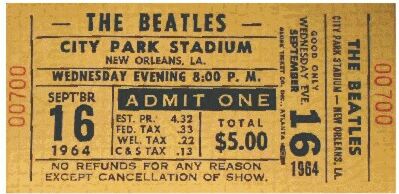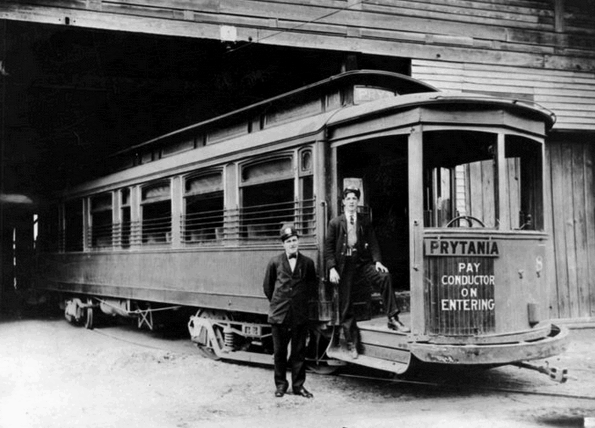|
Today in New Orleans History |
|
|
September 16


 To receive an update for each day in New Orleans history,
join our facebook page - Today in New
Orleans History.
 To receive an update for each day in New Orleans
history, join our facebook page
- Today in New Orleans History
Warren
Easton school celebrated its 100th year anniversary of the opening its current location on September 16, 2013.
Pioneering Crawfish Farmer Voorhies Trahan Dies Voorhies Trahan was, along with his second wife Aloncel "Ciel" Trahan (Credeur), instrumental in
pioneering the crawfish farming industry in Louisiana rice fields. Shortly after the end of World War II, Trahan was the
first farmer in the state of Louisiana to start producing crawfish in the same fields that he planted rice. This was done
by rotating the crops. The rice was a summer crop, while the crawfish were a winter crop.
According to biologist Percy Viosca, Jr., Trahan was given "full credit" for pioneering this method of producing
a crawfish crop. This method of crawfish farming continues today and has grown into Louisiana's largest freshwater crustacean
industry, with annual revenues that exceeds $300 million. Major League Baseball player Preston James Robertson died
in New Orleans on October 2, 1944. He pitched in two games for the Cincinnati Reds in 1913, thirteen games for the 1918 Brooklyn
Robins and seven games for the 1919 Washington Senators. Robertson was born on September 16, 1891 in Rockville, Maryland. The Prytania Streetcar Line was serviced almost exclusively by the "Prytanias," a luxurious
class of electric cars just as distinctive as the elegant "Garden District" neighborhood. Fifty cars were ordered
on April 21, 1910 from the St. Louisi Car Company. The exteriors were painted yellow and orange and their numbers ran
from 355 to 404. Mahogany interiors surrounded patrons seated in St. Louis rattan seats. They looked out of Robertson
windows that slid conveniently into side panels when open. The "Prytania" cars were designed for double-end operation
and the prepayment of fares, the first of its type in New Orleans. The 800 model
cars replaced the Prytanias on September 16, 1923. The Prytanias were then shifted to lighter traffic routes.
A public's changing preference for private transportation made streetcar operation unprofitable. According to a New
Orleans Public Service Inc. newspaper announcement, the Prytania Streetcar Line discontinued operations on October 1, 1932
and the Nashville Bus Line began service over a part of the territory formerly served by the line. Prytania Street, itself,
was not included. Remaining Prytanias were scrapped that same year. The Prytania streetcar barn was located on
Prytania Street between Robert, Pitt, and Upperline. After the city acquired the property, a 1936 ordinance dedicated
it for "public purposes". The location is now a shopping center, fronting Prytania, with a CVC pharmacy (4901
Prytania) as its anchor. Main Source: http://neworleanshistorical.org/items/show/540#.Ukfi9X9dy8A Writer Gwen Bristow is Born Communications Pioneer Frederick Britton Llewellyn is Born New Orleans Born Frederick Britton Llewellyn was a noted American electrical
engineer. He took a course at the Marconi School for Wireless Operators in 1915,
spent some three years in the merchant marine, and almost a year in the Navy in 1917-1918.
He then studied under Professor Alan Hazeltine at Stevens Institute of Technology, receiving
his M.E. degree in 1922. After a year as laboratory assistant to Dr. F. K. Vreeland, he joined Western
Electric in 1923, transferring in 1925 to Bell Telephone Laboratories, where he worked on
the long-wave transatlantic telephone based in Rocky Point, Long Island. From 1924-1928 he studied at Columbia University,
receiving his Ph.D. in 1928. Llewellyn helped develop the first public ship-to-shore telephone service,
inaugurated in 1929 on the SS Leviathan. In the 1930s he studied noise in vacuum tubes and constant-frequency oscillators,
and researched the behavior of vacuum tubes at very high frequencies. During World War II, he served as a consultant to
the Office of Secretary of War. He and Edwin H. Armstrong designed a sensitive receiver
used to detect a radar signal reflected from the moon (Project Diana). After the war, he served as
a consulting engineer, primarily on military electronics systems, assistant to the President of Bell Telephone Laboratories
1956-1961, affiliate of the Institute of Science and Technology at the University of Michigan 1961-1965, and research director
of the Polytechnic Institute of Brooklyn 1965 until retirement in 1967. Llewellyn
was president of the Institute of Radio Engineers in 1946, and awarded
the 1936 IEEE Morris N. Liebmann Memorial Award for his results on high-frequency electronics and constant-frequency oscillators.
He died on December 10, 1971. Archbishop Janssens is Installed Dutch-born Francis August Anthony Joseph Janssens served as Bishop of Natchez
(1881–1888) and Archbishop of New Orleans (1888–1897). He was born in Tilburg, North Brabant, to Cornelius
John and Josephine Anne (née Dams) Janssens and studied at the seminary of
's-Hertogenbosch from 1856 until 1866, when he entered the American College at Louvain, Belgium, with the view of dedicating
himself to the American missions. Janssens was ordained to the priesthood
on December 21, 1867. Arriving at Richmond, Virginia, in September 1868, he became rector of the cathedral in 1870 and served
as vicar general under Bishops James Gibbons and John Joseph Keane. On
April 7, 1881, Janssens was appointed the fourth Bishop of Natchez, Mississippi, by Pope Leo XIII.
He received his episcopal consecration on the following May 1 from Archbishop James Gibbons,
with Bishops Thomas Becker and John Keane serving as co-consecrators.
During his tenure he completed construction on the Cathedral of St. Peter the Apostle, which
had commenced forty years earlier. Janssens
was promoted to the fourth Archbishop of New Orleans, Louisiana, on August 7, 1888, and installed on the following September
16. During his tenure he convened the fifth Archdiocesan Synod
in May 1889, founded more than twenty-five new parochial schools, dedicated a new preparatory seminary at Gessen
in September 1891, and established the Catholic Institute for Deaf and Dumb at Chinchuba in 1890. Janssens significantly reduced the immense debt incurred by Archbishop
Napoléon-Joseph Perché; continuing the work of his immediate predecessor Francis Xavier Leray, he reduced it
from $324,759 to about $130,000. Janssens' tenure
also spanned the period of hardening racial divisions between whites and blacks. He once said, "There is nothing in
my administration of the Diocese that worries me more than our colored people; to see what is done by the Protestants to
capture them and how often they succeed. Believing that a separate parish would keep blacks within the Catholic Church and
facilitate black leadership just as it had for Irish and German immigrants, Janssens established St. Katharine's Church in
1895 as the first parish designated for black Catholics; attendance, however, was optional. It
was, however, his expressed hope "that anyone might occupy any pew or any seat anywhere in the church." Suffragette & Business Leader Vira Boarman Whitehouse (September 16, 1875 - April 11, 1957) was the owner
of the Whitehouse Leather Company, and a suffragette and early proponent of birth control. Vira Boarman was born in New Orleans on September 16, 1875, to Robert Boarman
and Cornelia Terrell, was educated in New Orleans, and attended Newcomb College. She
married James Norman de Rapelye Whitehouse, a New York stockbroker, on April 13, 1898. She was chairman in 1913 of the publicity
council of the Empire State Campaign Committee and in 1916 of the New York State Woman Suffrage Party (NYSWSP). She was
a leader in securing suffrage for New York women in November 1917. In 1918, she became director of
the Swiss office of the Committee on Public Information. She reported her experiences in A Year as a Government Agent
(1920). In 1921 she bought the Buchan-Murphy Manufacturing Company,
a leather business, renamed it the Whitehouse Leather Products Company, Inc., and reorganized it with herself as president.
She managed the company for eight years, reducing the work week from 48 hours to 44 hours, among other changes. In 1925 she was elected a member of the Democratic County Committee from Manhattan's 15th Assembly District.
In 1926 she became Chairman of the Independent Women's Committee for Judge Wagner.
She sold her leather company before the stock market crash of 1929. Mrs. Whitehouse died at her home in New York City on April
11, 1957.
|
|
|

To receive an update for each day in New Orleans history,
join our facebook page - Today in New
Orleans History.
Analytics |




